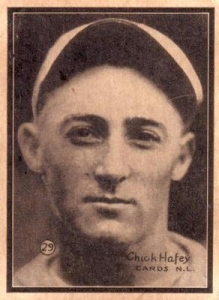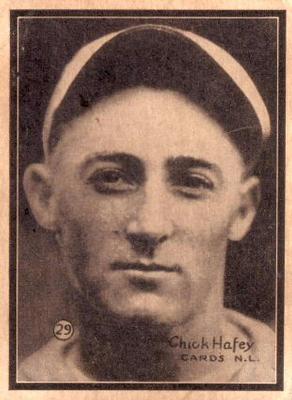July 6, 1929: Cardinals break 11-game losing streak with 28-hit, 28-run mauling of Phillies
 The St. Louis Cardinals were in a disastrous midseason slump on July 6, 1929, when they finally found their way to break out of it against the Philadelphia Phillies. The Cardinals’ loss in the first game of the doubleheader that day was their 11th consecutive defeat. (One tied game was sandwiched among the losses.) Then in game two it was as though the Cardinals were trying to make up for all their previous losses in a single game. They scored 10 runs in the first inning and then did it again in the fifth on their way to a 28-6 battering of the Phillies. The Cardinals’ 28 runs set a then-modern day record for runs scored in a major-league game.1
The St. Louis Cardinals were in a disastrous midseason slump on July 6, 1929, when they finally found their way to break out of it against the Philadelphia Phillies. The Cardinals’ loss in the first game of the doubleheader that day was their 11th consecutive defeat. (One tied game was sandwiched among the losses.) Then in game two it was as though the Cardinals were trying to make up for all their previous losses in a single game. They scored 10 runs in the first inning and then did it again in the fifth on their way to a 28-6 battering of the Phillies. The Cardinals’ 28 runs set a then-modern day record for runs scored in a major-league game.1
The Cardinals had been in first place by a half-game as late as June 18. It was familiar territory for manager Billy Southworth’s squad, as they had just won the National League pennant in 1928. But then the bottom fell out on their season. Beginning on June 16, the Cardinals went through a period of 20 games in which they won only two and tied one.
The Cardinals were in fourth place going into the doubleheader. Their impressive game-two win wasn’t enough to spur the team to make a dramatic turnaround for the rest of the season. In fact, first-year playing manager Southworth was swapped two weeks later with Bill McKechnie, who had been demoted to manage Rochester after leading the Cardinals to the 1928 NL pennant.2 However, a recalled McKechnie wasn’t able to revive the team, and they finished the season in fourth place.
Right-hander Fred Frankhouse got the starting nod from Southworth in game two. He was one of the youngest of a mostly veteran staff that helped win the 1928 pennant, including Jesse Haines, Pete Alexander, Bill Sherdel, and Clarence Mitchell. Frankhouse’s previous start, on July 1, lasted only five batters, as he gave up a double and three walks before being pulled from the game.
Claude Willoughby was the starting pitcher for the home-team Phillies. The 30-year-old was a smallish 5-foot-9 and 165-pound right-hander, appearing in his fifth season with the sixth-place Phillies. He was 9-7 coming into the game.
The Cardinals wasted no time jumping out to a huge lead in the top of the first inning. Willoughby didn’t retire any of the six batters he faced before being lifted for Elmer Miller, who entered the game with a 3-0 deficit. Two batters later, Miller left with a 5-0 lead by the Cardinals. Luther Roy relieved Miller and the first batter he faced, pitcher Frankhouse, drove in two more runs with a single. With the Cardinals having batted around by this time, leadoff batter Taylor Douthit’s single plated the eighth run of the inning. At that point, the Cardinals had sent 10 batters to the plate without recording an out. With two outs, Jim Bottomley got his second run-scoring single of the inning for the 10th run. The four Phillies pitchers didn’t give up any extra-base hits, but six singles and five walks were just as devastating.
The Phillies tried to bounce back in the bottom of the first. They loaded the bases against Frankhouse, but could muster only a single run on Fresco Thompson’s RBI single.
The two teams traded runs in the second inning. In the Phillies’ half, Frankhouse gave up three hits, including a home run by Denny Sothern, who hit in his 13th consecutive game. Neither team scored in the third, although Frankhouse was tagged for two more singles.
Roy yielded two runs in the fourth on run-scoring hits by Douthit and Carey Selph. The Phillies countered with a run on three singles, making the score 13-4.
In an already lopsided game, the Cardinals didn’t take any rest against Phillies pitching. They mounted another 10-run attack that sent 14 batters to the plate in the fifth inning. The highlights of the Cardinals’ second onslaught included Frankhouse’s second single that drove in two runs, Bottomley’s grand slam to deep right field, and Hafey’s two doubles that turned into scores. June Greene relieved Roy during the inning and was responsible for six of the Cardinals’ runs, including Bottomley’s four-bagger.
Frankhouse continued his pattern of giving up three hits in an inning, but the Phillies failed to push across a run in the fifth. However, he must have found the secret to keeping the Phillies off base during the next two innings, as he retired the side in order in both.
In the top of the eighth inning, Greene gave up five more runs on Andy High’s RBI single and a grand slam by Hafey to increase the score to 28-4.
The Phillies managed to score runs off Frankhouse in the eighth and ninth innings for a final score of 28-6. Lefty O’Doul, who was in his second major-league season as an outfielder after having begun his career as a pitcher, accounted for one of the RBIs on a sacrifice fly in the eighth.
The Phillies pummeled Frankhouse for 17 hits. Amazingly it was not a new record for hits allowed in a nine-inning complete-game win. The St. Louis Browns’ Ernie Wingard yielded 19 in a victory in 1925. The St. Louis Post-Dispatch reported that Frankhouse was bothered by a sore thumb and simply lobbed the ball over the plate after he was staked to a 10-run lead in the first, thus contributing to the high number of Phillies hits.3 The win was Frankhouse’s second of the year, and he would finish the season with a 7-2 won-lost record.
St. Louis amassed 28 hits and nine walks. Three innings accounted for practically all of the damage against the Phillies. Hafey and Douthit each recorded five hits, while Bottomley and Frankhouse each had four. Every batter in the lineup got at least one hit and scored at least two runs except second baseman Selph, who was replaced in the fourth inning by Eddie Delker. Douthit got on base seven times (five hits and two walks) in eight plate appearances and scored four runs. Bottomley led the team with seven RBIs. He had also smacked two home runs in Game 1. Douthit’s outstanding game was reminiscent of another Cardinals blowout in which he played in 1926, when he scored five runs by getting on base six times in seven plate appearances, including four walks.
Willoughby took his eighth loss of the season, but he wound up as the best starter on a staff that was the worst in the National League in 1929. He recorded a career-high 15 wins.
O’Doul led the National League in hits (254), batting average (.398), and on-base percentage (.465), and finished second to Rogers Hornsby for Most Valuable Player.
The Cardinals remained in fourth place for the rest of the season. While they continued to hover around .500, they dropped from 8½ games in back of the first-place Pirates on July 6 to 20 games behind the league-leading Chicago Cubs at the end of the season. St. Louis would return to a first-place finish in 1930 after McKechnie was replaced by Gabby Street.
The 1929 Cardinals team included six future Hall of Famers: Chick Hafey, Jim Bottomley, Billy Southworth, and three other players who did not appear in the July 6 blowout game (Frankie Frisch, Jesse Haines, and Pete Alexander).
Sources
In addition to the sources cited in the Notes, the author also consulted Baseball-Reference.com and Retrosheet.org.
Notes
1 Stan Baumgartner, “Cards Capture Second, 28-6, Making Record,” Philadelphia Inquirer, July 7, 1929: 1S.
2 Southworth had managed at Rochester in 1928, and even though McKechnie led St. Louis to a pennant that year, Cardinals owner Sam Breadon thought a change in managers for 1929 was needed. He had McKechnie and Southworth swap jobs to start the 1929 season.
3 J. Roy Stockton, “Cards Crush Phillies Under 28-6 Score After Losing by 10 to 6,” St. Louis Post-Dispatch, July 7, 1929: 3S.
Additional Stats
St. Louis Cardinals 28
Philadelphia Phillies 6
Game 2, DH
Baker Bowl
Philadelphia, PA
Box Score + PBP:
Corrections? Additions?
If you can help us improve this game story, contact us.


